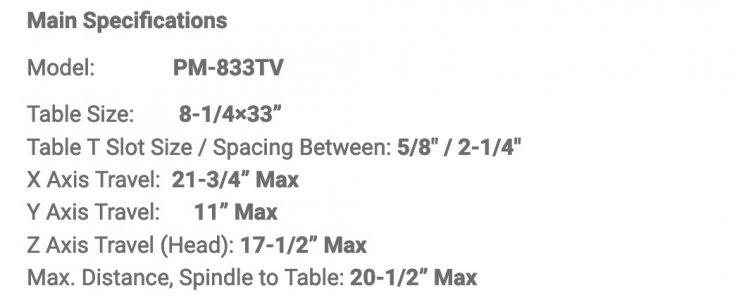- Joined
- Aug 3, 2017
- Messages
- 2,437
Thank you again everyone for all the super helpful info and support to the new guy. So much to read and so many videos to watch!
Here's where I'm at:
As far as PM bench mills go, the PM-833 is looking more and more like good fit for me. After seeing and hearing all of your feedback regarding working with 304 or 18-8 stainless, I think it would be best to stay in the 2hp camp no matter what style I end up choosing, and take the 1hp PM-728VT out of the running. Besides, the PM-833 seems to have just so much more to offer at a price increase that's within my budget. That being said, some of the drawbacks/limitations of this machine that I can see are:
1) Lack of a power down feed on the quill. I'd definitely opt for the power Z lift at time of order, but from the literature you've been providing, not having that quill down feed essentially takes boring operations off the table, at least not without some serious modification.
2) Lack of a power Y feed option. Not having a proper/steady feed rate could introduce difficulties when dealing with harder materials beyond aluminum. Not even having this as a future add-on option seems like a serious limitation to me.
3) I noticed in one of the videos that the y-direction table dimension on the PM-833 is 8-1/4 inches, compared to a common knee mill's 9+ inches. Correct me if I'm wrong, but I think this smaller dimension wouldn't allow me to mount a 6" vise horizontally, running the long way in x-direction. Is this a major disadvantage?
4) Nod adjustment will be a bit more challenging. I was hoping this to be a one-time set-and-forget thing, but I'll need to get my shims ready.
Regarding the knee mill option, it seems like just about everyone either ends up upgrading to one anyway, or highly suggests just biting the bullet right from the start and passing on the smaller machines. And to be honest, I can see why. Bridgeports and their clones have so much flexibility in what they can do, how easy it is to find replacement parts for them, and how well they hold their value. As a lowly woodworker and hobbyist though, I'm still not fully convinced that they're a perfect fit for everyone. As far as overall cubic volume and weight, many bench mills sit at about half their counterparts in both categories. For lighterm users and space-challenged individuals like myself, these are legitimate concerns when deciding on how much machine is really needed and how much machine we want hanging around our shop. What's a MAJOR bummer though is that these smaller, less capable bench mills are not half the price of the better used machines (i.e. BPs & clones)! From my shopping research, dollar for dollar, a used BP clone is equal to or less than a new bench mill. I think it's worth pointing out though, there is one key word difference here -- "used". As a newbie, knowing very little about metalworking, having the ability to differentiate between what's a "good" or "bad" machine in the world of used equipment is a serious gamble. Having no clue what I'm doing, then plopping down $6k on a piece of used equipment with absolutely no warranty or recourse of any kind, can be a scary proposition. If you have someone experienced enough to go shopping around with, that's great, but not everyone has access to that resource. Just sayin', there may be a method to all that "rookie madness".
It'll be fun looking back at this post 10 years from now. I'll probably cringe and smack myself in the head!
For #1: The lack of a power-quill 'stinks', but isn't a deal breaker. You can still use a boring head with manual feed, I did that a bunch on my millrite. You end up getting pretty good at feeding consistently
#2: Power Y can be added after the fact, but most of your operations are probably going to be feeding X anyway. My mill doesn't have Y, and I don't have a problem with it. Worst case, you get good at manual feeding.
#3: Thats DEFINITELY small compared to a Knee mill, ~12-15 is common in knee mills. That said, you'd have no problem mounting a 6" vise either direction, its a pretty good sized table. HOWEVER, with a mill that size, a 6" vise is going to be pretty crowded. I had a Millrite (which had a slightly bigger table), and always felt like the 6" was a bit too large.
#4: The lack of nod was one of the reasons I got rid of my millrite. However, it IS a once-and-done thing, and is likely easier on the 833 than the millrite.
I suspect you'll likely be happy with the 833 for quite a while. Its a little less capable than a knee mill, but not horribly so. You'll take lighter cuts, but still be able to get the same accuracy. You'll have a somewhat smaller envelope, but that is rarely a problem for most folks. A knee mill is GREAT, particularly knowing you can cut anything you want at any time. BUT, unless you're really concerned about the time (or if time is money!), a couple of extra passes isn't a big deal.
AS Far as price: you're right, you have to spend ~2x to get into a nice new bridgeport clone (even a 9x49). I would perhaps suggest getting as much as you can out of the 833, and keep an eye on craigslist/et-al for a while and see if you can find a cheap bridgeport someday (again, if you're wiling to dedicate the space!).


